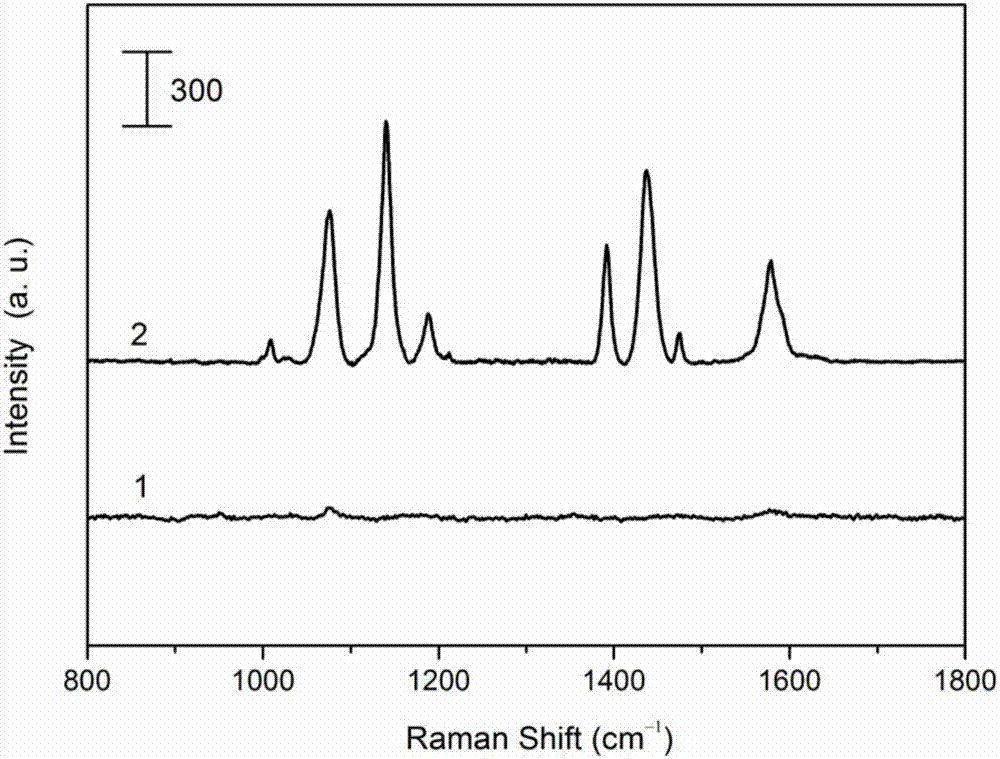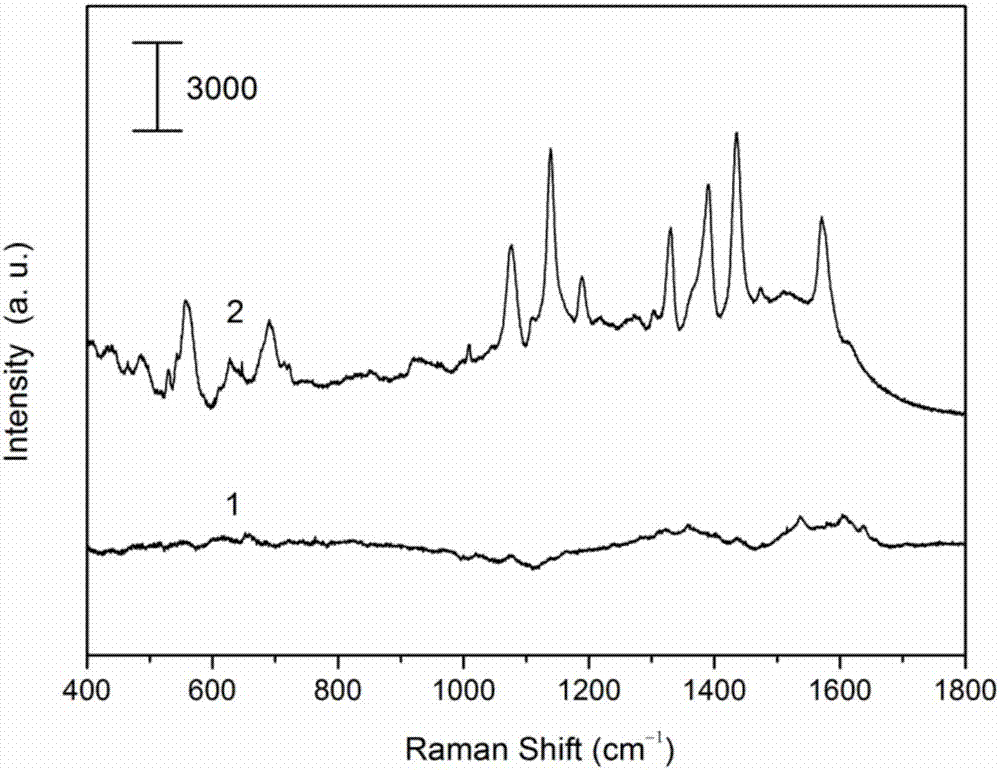Method for improving detection sensitivity of SERS substrate by using molecular template enhanced reagent
A technology of detection sensitivity and molecular template, which is applied in the detection field to achieve the effect of improving the enhancement effect, realizing ultra-trace detection, and realizing the effect of sensitivity
- Summary
- Abstract
- Description
- Claims
- Application Information
AI Technical Summary
Problems solved by technology
Method used
Image
Examples
Embodiment 1
[0034] Example 1: Application of the SERS substrate binding enhancement reagent technology with silver nanoparticles assembled on the surface in the detection of p-mercaptoaniline (PATP) molecules
[0035] 1. Preparation of silver sol: Dissolve 36mg of silver nitrate in 200mL of water, heat rapidly to boiling, add 4mL of sodium citrate aqueous solution with a mass concentration of 1% rapidly under vigorous stirring, keep the slightly boiling state and continue to react for 1.5 hours, then naturally After cooling and stirring to room temperature, the resulting sol was brown-gray. A silver nanoparticle sol with a particle size of 70 nm was obtained. Assembly of silver nanoparticles on a glass substrate: the glass substrate was ultrasonically cleaned in water, ethanol, acetone, chloroform, acetone, ethanol, and water for 5 minutes, and then placed in 30% H 2 o 2 Aqueous solution and 98% H 2 SO 4 Water solution (volume ratio: 3:7) boiled in the mixture for 20 minutes, washed w...
Embodiment 2
[0039] Example 2: Application of Gold Nanoparticles as SERS Substrate Binding Enhancement Reagent Technology in Detection of p-Mercaptobenzoic Acid (MBA) Molecules
[0040] 1. Preparation of gold nanoparticle sol: first prepare chloroauric acid into an aqueous solution with a mass concentration of 0.01%, take 100 mL and heat it to boiling. Accurately add 2.5 mL of sodium citrate aqueous solution with a mass concentration of 1% under stirring, and continue to boil for 15 minutes. At this time, it can be observed that the solution changes from light yellow to gray quickly, then to black, and then gradually stabilizes to red. After cooling to room temperature, the gold nanoparticle sol was obtained.
[0041] 2. Assembly of gold nanoparticles on a glass substrate: ultrasonically clean the glass substrate used in the experiment in water, ethanol, acetone, chloroform, acetone, ethanol, and water for 5 minutes, and then place it in 30% H 2 o 2 Aqueous solution and concentrated H w...
Embodiment 3
[0045] Example 3: Application of silver nanoparticles as SERS substrate binding enhancement reagent technology in detecting rhodamine 6G (R6G) molecules
[0046] 1. Preparation of silver sol: Dissolve 36mg of silver nitrate in 200mL of water, heat rapidly to boiling, add 4mL of sodium citrate aqueous solution with a mass concentration of 1% rapidly under vigorous stirring, keep the slightly boiling state and continue to react for 1.5 hours, then naturally Cool and stir to room temperature. The obtained sol was brownish gray, and a silver nanoparticle sol with a particle size of 70 nm was obtained.
[0047] 2. Assembly of silver nanoparticles on a glass substrate: ultrasonically clean the glass substrate used in the experiment in water, ethanol, acetone, chloroform, acetone, ethanol, and water for 5 minutes, and then place it in 30% H 2 o 2 Aqueous solution and concentrated H with a mass concentration of 98% 2 SO 4 Aqueous solution (volume ratio is 3:7) in the mixture liqui...
PUM
| Property | Measurement | Unit |
|---|---|---|
| diameter | aaaaa | aaaaa |
| particle diameter | aaaaa | aaaaa |
| diameter | aaaaa | aaaaa |
Abstract
Description
Claims
Application Information
 Login to View More
Login to View More - R&D
- Intellectual Property
- Life Sciences
- Materials
- Tech Scout
- Unparalleled Data Quality
- Higher Quality Content
- 60% Fewer Hallucinations
Browse by: Latest US Patents, China's latest patents, Technical Efficacy Thesaurus, Application Domain, Technology Topic, Popular Technical Reports.
© 2025 PatSnap. All rights reserved.Legal|Privacy policy|Modern Slavery Act Transparency Statement|Sitemap|About US| Contact US: help@patsnap.com



